« First Scuba certification anniversary and diving Tahoe again | Main | Diving the Wall off Rubicon Point, Lake Tahoe »
August 13, 2007
Diving Meeks Bay, Lake Tahoe
So finally it was time again to go dive. I had planned to get up bright and early and leave at 7AM or so for the 100 mile road drive from Folsom to Tahoe, but it's just amazing how much stuff one needs to tag along for a dive trip. The day before, I had a second car key made at a local hardware store, one without the transponder built into the plastic FOB of almost every new car these days, and used a key ring to securely attach it to the BC. All in all it was almost 10AM by the time the PT Cruiser was finally on the road and headed on up Route 50 into the Sierra Nevadas. It was a beautiful sunny morning and the drive up the winding mountain roads was glorious. 4000 feet, 5000 feet, 6000 feet, 7000 feet, and then pass the summit at 7,420 feet. The lower pressure at that altitude meant, according to PADI, that I was now off-gassing and basically equivalent to a diver emerging from his initial dive of the day, and finding himself in the PADI dive table pressure group "P."
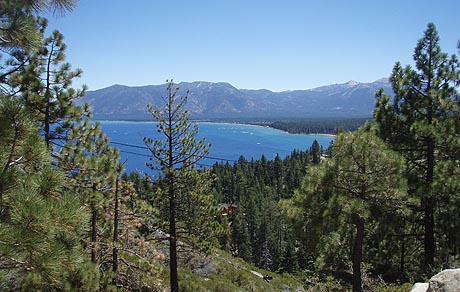
The first peek at Lake Tahoe from high up is always breathtaking, and this day the air was so clear that it sparkled in a deep, deep blue and you could see forever. For a while Route 50 and Route 89 go together towards Lake Tahoe, then, once you reach the lake, 89 goes up north along the Western shore of Lake Tahoe, up and down the mountain sides with such majestic vistas that you feel tempted to stop again and again to take pictures. We did have enough cameras on board for that, of course, and so it was almost noon by the time we'd successfully located the small Meeks Bay park about five miles north of Emerald Bay. There is no ranger station, but just a machine that spits out a ticket in exchange for a five dollar bill. That's more than fair for a day's worth of fun at Lake Tahoe. I had been a bit concerned about finding parking as there are but a couple dozen spots, but we all got lucky.
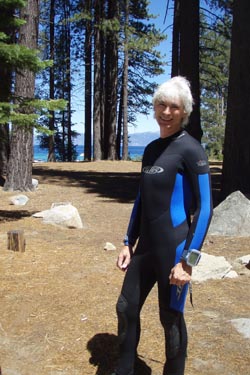 So then it was time to lay out the diving gear and for me to begin the usual struggle with my 7mm Telos wetsuit. Though it was only 80 degrees or so, the sun was burning down and the air at Lake Tahoe -- 6,230 feet above sea level -- is a good deal thinner than I'm used to. After a lot of grunting and the occasional swearword or two we're all suited up, steel 95s on our backs, and we walk on over to the beach.
So then it was time to lay out the diving gear and for me to begin the usual struggle with my 7mm Telos wetsuit. Though it was only 80 degrees or so, the sun was burning down and the air at Lake Tahoe -- 6,230 feet above sea level -- is a good deal thinner than I'm used to. After a lot of grunting and the occasional swearword or two we're all suited up, steel 95s on our backs, and we walk on over to the beach.
We see a trio of divers that had just returned from a dive and so we stop by to say hello. At Tahoe you know the visibility is great -- no need to ask -- and so we inquire about the temperature instead. 67 degrees Fahrenheit at the surface, but just 55 or so at 90 feet they say. Yes, hoods and gloves would be a good thing; they'd worn them. We'd brought those along, but it's hard to see them as necessary when you're sweating like a pig and about to have a heatstroke, so they remained in the car. All I heard was 90 feet. They had actually gone down the slope to 90 feet at Meeks Bay?! I remembered the sandy, featureless drop descending at a 45 degree angle and how it had felt a bit scary for me to descend to 58 feet last Fall.
A good number of people enjoy the pristine beach, but it isn't too crowded. We can't wait to get into the clear water and it does feel good. I cool off, recover from walking from the parking lot to the water in my wetsuit and all my gear, put on my fins (still always a struggle after all this time) and then it's time to go under. I carry 12 pounds of weight total -- two 4 pound bags in the left and right pockets of my weight-integrated Scubapro Knighthawk BC, and two 2 pound baggies in the back/shoulder pockets of the BC.
We descend to the sandy bottom at 15 feet or so. I am breaking my own rule of never wearing a new (to me) mask on a real dive by using one that has built-in corrective lenses so I can better see my dive computer and the controls and screen of my camera. It's an interesting design, with the bottom of the mask lens consisting of two magnifying pieces of glass at an angle so you can look down at your instruments or dive computer. I give it a quick test. I can clearly see and read the LCD display of my UWATEC SmartZ dive computer, and also the tiny controls of the Olympus 770 SW underwater camera I'd brought along. The mask isn't fogging up and it seems to have a good enough fit for the shape of my head that it doesn't leak. However, the straight lines where the two glass panes meet is distracting and I have to tilt my head more, and can see less, than I expected.
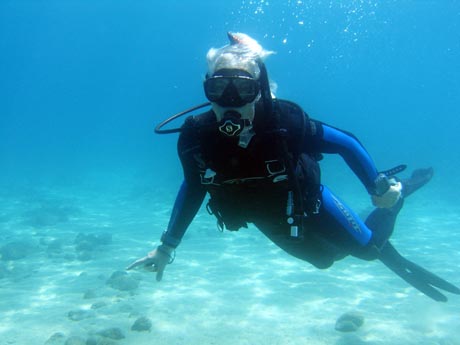
Someone apparently had some fun on the sandy bottom. Perhaps decompressing, they'd written "BE GOOD" with brick-sized rocks, and also "GT" and I wonder if that is in reference to a diver's car (such as my PT Cruiser GT). But on we move, out to the buoy where we're supposed to take a right so as to stay clear of the marina with its boats. Meeks Bay is on the California side of Lake Tahoe, and so a dive flag isn't required, though the regulations -- which I had looked up -- are exceedingly murky and confusing.
The water feels good. Cool and refreshing rather than cold. About eight minutes into the dive we reach the slope, but it isn't like what I had seen last year. It's not the sandy, featureless 45-degree slope. Instead, we're farther south where the huge rocks and boulders are. I look around and it's beautiful. The visibility must be over 100 feet. I hover amidst hundreds or thousands of glistening little fish, schools of minnows perhaps. It feels like sitting in an IMAX theater and watching an underwater movie where the fish are all around you and you feel you can just reach out and touch them. Except that this is real. But instead of your hand going through the 3D IMAX fish, these live ones simply dart out of the way. I could have just hung there in wonder, watching those fish and the giant boulders.
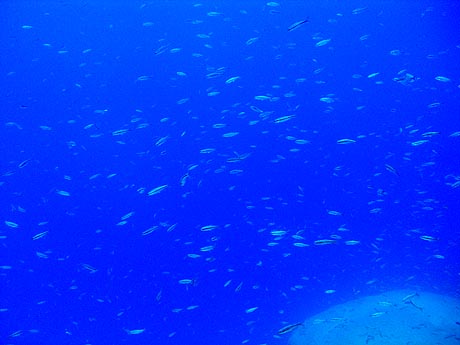
But we move on and are now on a rather steep slope with huge boulders, very different from what I saw last year. There is apparently more to Meeks Bay than I first though. It is not just a simple beginner's dive.
For some reason I am not 100% comfortable. The mask with its optical inserts narrows my field of vision, something which I don't like at all. I take some pictures with the Olympus 770 but don't pay much attention to it. We stop at around 70 feet, deeper than I had ever gone before. I still don't feel quite right. The visibility is great, so that is not it. But as we stop I am very aware that we have 70 feet of water above us and for a moment I wonder what would happen if something went wrong with my body or I panicked. Staying put gives me time to think about this and I don't like it. So I hover and swim around to shake off the uneasiness until it's time to move on.
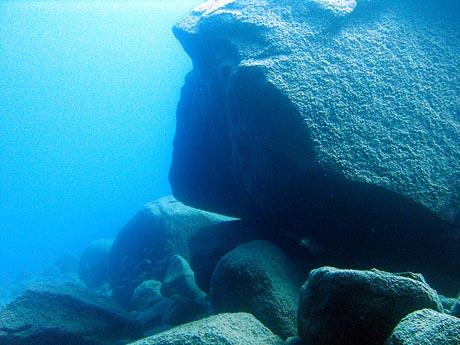
We're going deeper and it's getting pretty cold now. My dive buddy gives me a sign but I can't quite figure out what she's trying to tell me. She motions for me to follow, but I am at 94 feet already and don't feel like descending deeper. She does, takes a picture with her Casio S500 in its deepwater case, then returns and points at her dive computer. She'd gone to 100 feet in Lake Tahoe. Given that we would have to return up to the 7,440 foot summit, which is rounded up to 8,000, 100 feet represents an altitude-adjusted depth of 134 feet in the Altitude-Adjusted Dive Depths tables. Later I'd wonder if perhaps I'd felt a bit of nitrogen narcosis. I didn't feel weird or euphoric or paranoid, but it also never occurred to me that I was holding the Olympus 770 camera in my hand, the one rated at 33 feet but that had accompanied me without ill effects down to 67 feet at Manatee Springs State Park. This was almost 30 feet deeper.
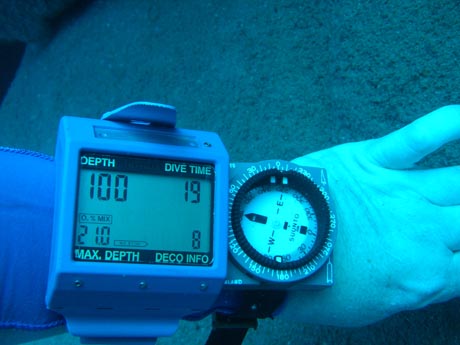
For the next ten minutes we slowly ascend, weaving our way through and around all those rocks and boulders until we're back up at 30 feet. The temperature quickly rises from 55 to 66 degrees, but by now I am cold. We again see the schools of little silvery fish and occasionally a bigger one, and some pretty sizable crawdads. They are usually feisty fellows, swinging their claws at us and definitely not willing to give an inch.
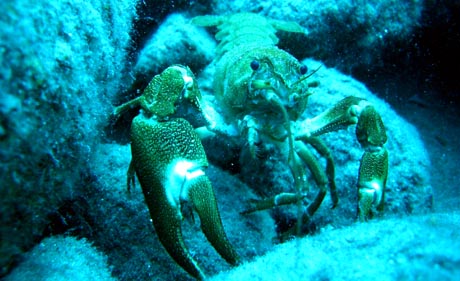
We continue exploring for another ten to 15 minutes at around 20 feet and then it happens: I am unable to dump air from my Knighthawk BC and feel myself rising. I hold up my Air2 with its dump valve, but no matter how hard I push, no air comes out. I try to swim down, but it's too late. I am already at the surface. No real big deal, but I am upset with myself!
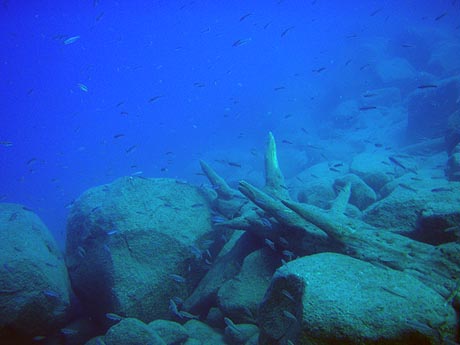
Now I am really cold, with my whole body just shivering away. We get out of the water, and then just sit for a while, recovering. It'd been a great dive. There aren't too many places with 100+ feet of visibility, grand underwater vistas, the ability to go as deep as you're comfortable with, and it's all easily reachable from the shore. In addition, the water is crisp and clean and clear. What more can one ask for?
Posted by conradb212 at August 13, 2007 11:17 PM








